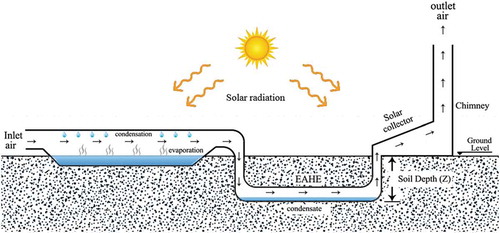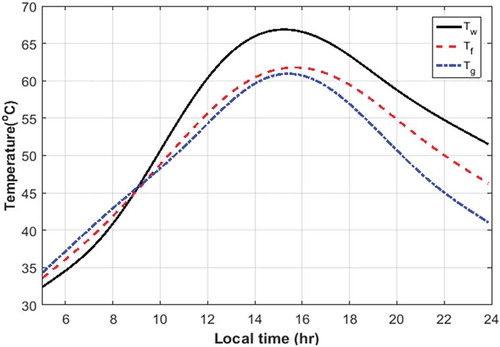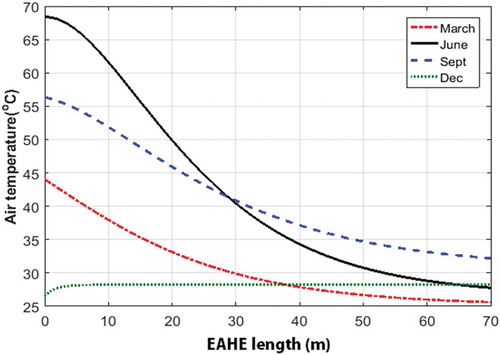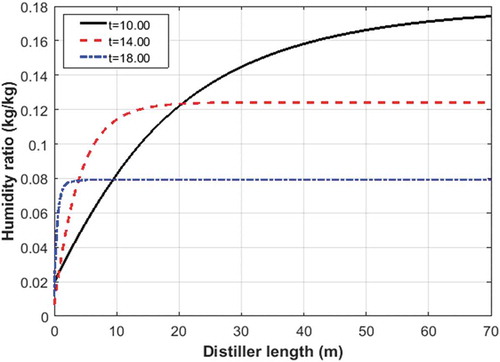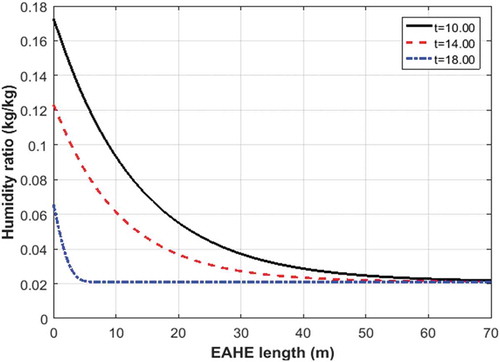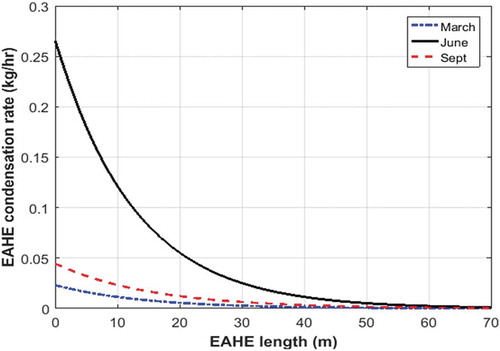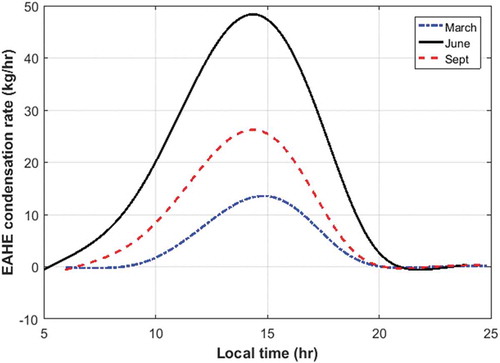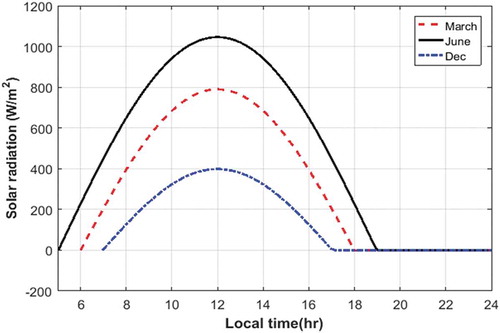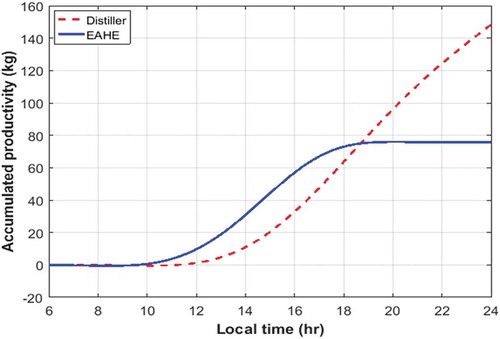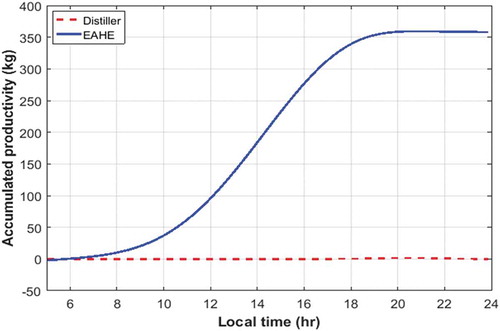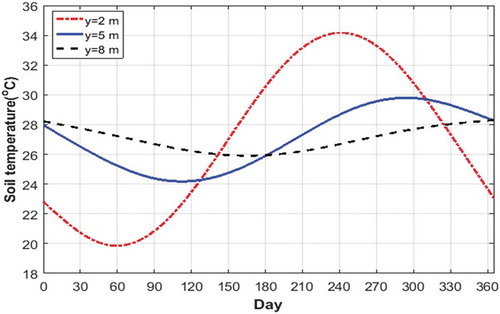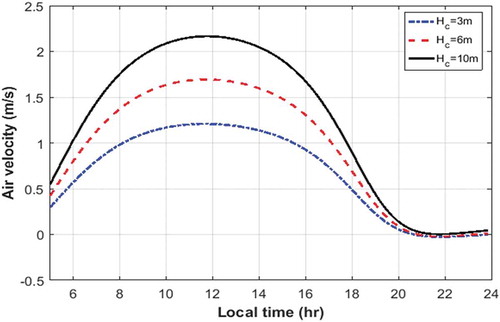 ?Mathematical formulae have been encoded as MathML and are displayed in this HTML version using MathJax in order to improve their display. Uncheck the box to turn MathJax off. This feature requires Javascript. Click on a formula to zoom.
?Mathematical formulae have been encoded as MathML and are displayed in this HTML version using MathJax in order to improve their display. Uncheck the box to turn MathJax off. This feature requires Javascript. Click on a formula to zoom.ABSTRACT
A theoretical study of humidification-dehumidification (HDH) processes inside a system combining a solar still with an earth-air heat exchanger and a solar chimney was introduced. Energy and mass balances in a transient mode for the solar still and the earth-air heat exchanger in addition to the solar chimney were formulated and numerically simulated. The solar radiation heats water in the solar still basin, which in turn warms and humidifies dry air entering the solar still due to the heat and mass transfer into the airstream. When the glass/or the EAHE pipe wall temperatures are lower than or equal to the dew point of the humid air, the vapour condenses and runs down. The results show that the water, the air, and the glass temperatures increase with time to reach their maximum values (66.9 oC,61.8 oC, and 61.24 °C respectively) in June from 15.00 to 16.00. The humidity ratio along with the solar still length increases to reach a uniform value whenever the moist air is saturated. At the same time, the humidity ratio along EAHE decreases due to the condensation of the moisture inside the EAHE pipe. The condensation rate in the EAHE decreases gradually along a pipe length of 70 m until it completely vanishes at the pipe outlet. The hourly condensation rate in the EAHE attaining its maximum value of 49.27 kg/hr. at 14:32 (Basra local time) in June where the solar radiation is at maximum value. Also, the results indicated that the productivity of freshwater in the solar still is strongly affected by the water, air, and glass temperatures. The maximum productivity in the solar still achieved in March was 157 kg/day while it was 369 kg/day in July for the EAHE. The increase of the air velocity increases the productivity in EAHE and decreases it in the solar still. The daily average freshwater production for the system (solar still and the earth-air heat exchanger) throughout the year was found to be 207.44 kg. The thermal efficiency of the system over the interval from 6:00 to 19:00 was found to be 0.23–0.55. The economic evaluation showed that the cost of freshwater production was 0.0282 $/kg. A comparison of the current analysis with other works showed a good agreement.
1.Introduction
The main objective of this study is to produce freshwater by using a combination system of a solar still and an external underground condenser with the benefit of a solar chimney for natural air motion of humid air through the system. Freshwater production is of vital importance especially in warm weather zones, which are known for having the highest water consumption for drinking, irrigation, and industrial activities. In remote areas, the energy transpose can prove to be quite difficult and costly; in this case, solar energy is considered the better alternative. Solar energy is widely used for desalination processes around the world most notably in the sunny and high solar intensity regions. A considerable number of researches available in the literature deals with a simple solar desalination system like solar still with some modifications to enhance the productivity of freshwater like Keshtkar, Eslami, and Jafarpur (Citation1993), Abdullah et al. (Citation2020), Zanganeh et al. (Citation2020), Ali et al. (Citation2020), Ayman and Hassan (Citation2020). Several investigations found in the literature take the effect of air movement inside the solar still into account. Among these studies is the work by Ali (Citation1991). He presented experimental research on-air motion effect inside a solar still of a 3 m2 area to enhance the low yearly productivity of the still (3 L/ m2 day). His results show a 29.7% increase in the desalinated water when the air is allowed to move inside the solar still. Also, Ali (Citation1993) theoretically studied the effect of forced convection inside a solar still on heat and mass transfer coefficients bearing in mind the impact of turbulent air eddies, vapour velocity inside the still, and accumulation of non-condensable gas. He concluded that the productivity of the solar still increases with the increase of Reynold’s number, but it falls after reaching a maximum value at Re = 52,800.
The freshwater extracted from the humid air in buried pipes is recently studied. Lindblom and Nordell (Citation2006) studied a combined system for desalination and irrigation by underground condensation of moist air. They used solar radiation to evaporate seawater and let the humidified air transport into an underground pipe system. Their numerical simulations of this system result in water production of (1.8 kg/m. day) over a 50 m long pipe. Besides, Lindblom and Nordell (Citation2007) extended their previous study by presenting a theoretical simulation on systems for drinking water production and for subsurface irrigation to examine the potential for using the condensation Irrigation (CI) technology. Their model used arrays of 50 m long pipes, spaced 1.0 m apart and buried at 0.5 m depth. They found that the mean water production rate was 3.1 kg/m.day when they used drainage pipes for subsurface irrigation.
Recently Okati, Behzadmehr, and Farsad (Citation2016) presented a study of a solar still including a compound system consisting of a solar humidifier and underground condenser. The amount of produced water per length of 0.2 diameter pipe buried in the ground is 3.8 kg⁄m.hr. Also, Okati, Farsad, and Behzadmehr (Citation2018) extended their previous work by presented a numerical analysis of integrated humidification-dehumidification desalination unit and underground heat exchanger. Different numbers of buried pipes were taken, and the pipe wall temperature was considered as 17 °C. Their results indicated that the rate of water production could reach above 264.86 (kg/day) when they used an underground condenser of eight pipes (50 m length).
Ghazy and Fath (Citation2016) studied solar desalination through a system that combined solar still and humidification-dehumidification unit. The main components of the system are a conventional solar still, humidifier, and dehumidifier. The moisture is extracted from the humid air in an external condenser(dehumidifier) that is cooled by water. Their simulation showed that the thermal efficiency and water production of the integrated system is about 1.5 times that of the conventional solar still under the same conditions. Bhargva and Yadav (Citation2020) presented a theoretical and experimental study on a solar still combined with evacuated tubes and a heat exchanger. Experimental results showed maximum daily productivity of 7.38 L/m2. day and daily efficiency of 30.5% achieved for modified still at 4 cm water depth. Sivaram et al. (Citation2021) carried out an experimental study to produce clean water from any brackish water. Their study focused on the improvement in efficiency by providing a passive external condenser with a stepped design of evaporator. They showed that the passive external condenser increases the overall efficiency of still by 10.6% in summer and 12.2% in winter. Mohamed, Shahdy, and Ahmed (Citation2021) performed a theoretical and experimental study of a solar humidification-dehumidification water desalination system based on a closed-air cycle. The impact of air flow rate, water to air mass ratio, and cooling water flow rate on water productivity have been investigated. Their experiments have been conducted at water temperatures of 40°C, 50°C, 60°C, and 70 °C. An increase in water temperature by 10 °C leads to an increase in freshwater production with an average of 69%. The results show that increasing air flow rate leads to increasing water productivity, while it reduces humidifier and dehumidifier efficiencies. They found that the maximum productivity was 6.32 kg/h at a cooling water flow rate of 6 kg/min.
The current study is a combination of a solar still, an earth-air heat exchanger, and a solar chimney. In this system, the solar radiation heats the water in the solar still basin, which in turn warms and humidifies the airstream due to heat and mass transfer from the water. A solar chimney is used to drive air through the solar still and the EAHE pipes. The freshwater will be extracted from the humid air by condensation of vapour in both the solar still and the earth-air heat exchanger. The previous studies available in the literature usually simplifying the mathematical model by neglecting the condensation on the glass cover of the solar still and considered only the condensation inside the buried pipes furthermore forced air circulation was used throughout the system. In the present work condensation on the glass cover which has significant productivity in the cold and moderate seasons as well as condensation in an earth-air heat exchanger is considered. A solar chimney is implemented for the natural movement of humid air in a zero-energy desalination system.
2. Theoretical analysis
2.1 The solar still
The solar still is a pool that has two openings, one to inlet dry air, and the second is to leave the humid air. The solar radiation incident on the solar still heated and humidified the air. The heat and mass transfer balances of the solar still depend upon whether condensation occurs on the glass cover or does not. If the temperature of the glass cover is equal to or below the dew point of the humid air, vapour will begin to condense on the glass cover (see ). The main assumptions used in the time-dependent mathematical model are:
1. One-dimensional flow in the entire system.
2. The solar still’s basin and the solar chimney wall are perfectly insulated.
3. The soil temperature is a function of time and depth only.
4. The heat resistance of the buried pipe wall is neglected.
The energy balance of the solar still becomes:
In the case of no condensation, the term ( which represents the latent heat released is zero.
The four terms of the right side of Equationequation (1)(1)
(1) are given as:
The humidity ratio at the water temperature of Equationequation (3)(3)
(3) is determined as: (Amer et al. Citation2009).
The saturated vapour pressure in Equationequation (6)
(6)
(6) is expressed as follows:(Sharshir et al. Citation2016),
Elango, Gunasekaran, and Sampathkumar Citation2015).
The humidity ratio of air is given as: (Hamed et al. Citation2015).
Where is the saturated pressure at the air temperature, which is expressed as follows:
The humidity ratio at the glass temperature in Equationequation (5)
(5)
(5) is given as:
Where is saturated pressure at the glass temperature, which is given as:
The heat transfer coefficients for water – airstream and airstream-glass cover
are considered as follows:(Okati, Farsad, and Behzadmehr Citation2018; Sartori Citation2006).
The latent heat of water vapour is given as: (Okati, Behzadmehr, and Farsad Citation2016; Rogers and Yau Citation1989).
The enthalpy of saturated vapour at air temperature can be determined as: (Okati, Farsad, and Behzadmehr Citation2018),
Cengel and Boles Citation2001).
The humidity ratio for each element of dx length along with the solar still can be calculated from the mass balance equation as follows:
The evaporation and condensation rates are given as: (Molineaux, Lachal, and Guisan Citation1994; Okati, Farsad, and Behzadmehr Citation2018).
The dew point of the humid air is given by:(Lawrence Citation2005).
The glass temperature that appeared in Equationequation (4)(4)
(4) can be determined using the energy balance for the glass cover as follows:
The outside heat transfer coefficient is given as: (Hassan, Elsherbiny, and Ghazy Citation2004; Hammadi Citation2018).
If no condensation on the glass (); the term
is eliminated from Equationequation (19)
(19)
(19) .
2.1.1 Solar radiation and ambient temperature
The total solar radiation incident on a horizontal surface estimated by curve fitting of data presented by Al-Enezi, Sykulski, and Nabil (Citation2011):
Where N is the month number.
The hourly solar radiation incident on the solar still is given as: (Hammadi Citation2018; Chaabene and Annabi Citation1997; Mawire and McPherson Citation2008).
Where S is the day length, which can be estimated from the following relation: (Besharat, Dehghan, and Faghih Citation2013).
The declination angle is given as:(El Mghouchi et al. Citation2016).
The hourly ambient temperature throughout the day which appears in Equationequation (19)
(19)
(19) is determined using the following formulas:(Reicosky et al. Citation1989).
For day
For night
2.1.2 Evaluation of air temperature and humidity ratio
EquationEquations (1(1)
(1) , Equation15
(15)
(15) , and Equation19
(19)
(19) ) can be solved numerically to evaluate the air temperature and humidity ratio along with the solar still length. If the glass temperature is higher than the dew point of the air, no condensation will occur, and the terms
and
are eliminated from Equationequations 1
(1)
(1) and Equation19
(19)
(19) respectively. The water temperature in the solar still basin
varies with the variation of solar intensity throughout the day. It can be calculated from the following time-dependent energy balance of the water layer:
The average air temperature and humidity ratio for any time interval along with the solar still can be determined numerically using the following relations:
2.2 Earth -Air heat exchanger model
After the humid air leaves the solar still, it enters the EAHE pipes. If the pipe wall temperature is equal to or less than the dew point of the air, condensation will occur and release the latent heat as well as to the sensible heat due to the temperature difference between the air and the pipe wall. The energy balance of the earth-air heat exchanger considered is written as:
The convective heat transfer from the air to the pipe is:
The heat released by condensation can be expressed as:
For constant wall temperature, the dimensionless mass transfer coefficient depends on the flow type. In the case of laminar flow, it can be given as: (Çengel and Ghajar Citation2015).
For turbulent flow, number is: (Estrada et al. Citation2018).
The mass transfer coefficient is expressed by: (Incropera Citation2006).
Where can be expressed in term of
as follows: (Çengel and Ghajar Citation2015).
Where; is the mass diffusivity, which is given by: (Çengel and Ghajar Citation2015).
The humidity ratio for each element along with the length of the earth–air heat exchanger, is expressed as:
The condensation rate in the EAHE is:
If no condensation, the air temperature in the EAHE can be determined by integrating Equationequation (30)(30)
(30) to give:
The soil temperature for any depth at any time can be evaluated using the following formula: (Ozgener, Ozgener, and Tester Citation2013).
The values of Tm, As, and to are taken as 27 °C, 13.3 °C, 0.0038 m2/hr, and 552 hr respectively, therefore, the last equation becomes [33]: (Al-Ajmi, Loveday, and Hanby Citation2006).
In the current work, the pipe wall temperature is taken equal to the soil temperature. This assumption has been addressed by (De Paepe and Janssens Citation2003) and (Fuxin et al. Citation2015).
2.3 Solar chimney
A simple energy balance equation for the solar chimney is written as follows;
The updraught air velocity in the chimney is given by: (Bassiouny and Koura Citation2008).
Where the mass flow rate can be expressed as:
Using Equationequations (43(43)
(43) , Equation44
(44)
(44) , and Equation45
(45)
(45) ), the air velocity in the chimney becomes:
The value of discharge coefficient (cd) is taken as 0.57 (Bassiouny and Koura Citation2008; Jianliu and Weihua Citation2013). EquationEquation (46)(46)
(46) can be easily solved numerically to evaluate the air velocity in the solar chimney at any time.
The solar radiation and the ambient temperature are taken according to Basra climate conditions (latitude 30.5, longitude 47.8) throughout the year. EquationEquation (27)(27)
(27) was solved numerically using the Euler method with a time interval of (300 seconds) to evaluate the water temperature as a function of the local time. The Equationequations (1
(1)
(1) , Equation15
(15)
(15) , and Equation19
(19)
(19) ) are resolved to evaluate air temperature and humidity ratio at any time for any location along with the solar still length.
2.4. Experimental validation
To validate the present theoretical model with other experimental and numerical works, the water temperature and the evaporation rate in the solar still throughout a time interval of 4:00–24.00 are compared with the results of Sartori (Citation1996) and Okati, Farsad, and Behzadmehr (Citation2018) in . The changes in the water temperature and the evaporation rate are similar in the three works. This indicates the validity of the present work results.
Table 1. Experimentally and numerically validation of the present work with Sartori (Citation1996) and Okati, Farsad, and Behzadmehr (Citation2018) works
3. Results and discussion
A combination of a solar still, earth-air heat exchanger system and the solar chimney was analysed under Basra climate conditions (south of Iraq). tabulated all the inlet parameters utilised in the calculations. The solution procedure includes simultaneous solving of the governing equations of the solar still, the earth-air heat exchanger, and the solar chimney. The solar still channel was divided into small elements of 0.1 m in length. The solution covered the entire length of the solar still for a time interval of 300s to determine the temperature, the humidity ratio, and the other heat and mass transfer characteristics. The air that leaves the solar still enters the earth-air heat exchanger where heat and mass transfer from the humid and warm air to the wall of the pipes. The EAHE pipes were divided into small elements of 0.1 m in length. The solution included checking whether condensation occurs on the EAHE pipes or not, depends on the dew point of the air and the temperature of the pipe’s wall. The air temperature, humidity ratio, and condensation rate along the EAHE are calculated by solving Equationequations (30)(30)
(30) and (Equation38
(38)
(38) ) simultaneously.
Table 2. Inlet parameters
The air is then drawn up through the solar chimney where the air velocity is calculated by solving Equationequation (46)(46)
(46) numerically. The water temperature in the solar still now can be estimated by solving the time-dependent Equationequation (27)
(27)
(27) using the Euler method. The procedure is repeated for the next time interval and continues to cover a period from sunrise to midnight for each month around the year. All calculations are performed by building a program using the Matlab platform.
3.1 Variation of temperature
shows the water, the average air, and the average glass temperature profiles of the solar still during June. It is clear that the temperatures increase with time to reach maximum values at an interval between 15.00 and 16.00 then they start to go down. Such behaviours are due to the variation of the solar radiation incident on the solar still during the day. The air temperature along EAHE at the four seasons of the year is shown in . The temperature gradually decreases with the EAHE length due to the sensible and latent heat removal from the air to the wall of the pipe. In all cases, the air temperature ultimately converges to the pipes wall temperature, or in other words, to the soil temperature, which are 24 oC, 26 °C, 30 °C, and 28 °C, in March, June, September, and December, respectively.
3.2 Humidity ratio
explains the change of humidity ratio along with the solar still length at different times. The humidity ratio increases along with the solar still length due to the mass transfer from the water to the airstream. It is noted that the humidity ratio decreases with time over the major part of the solar still and reaching a uniform value faster at t = 18.00, because of reducing the solar radiation, which leads to lower water temperature and less evaporation potential. shows a decrease in the humidity ratio along the EAHE due to the continuous condensation process. Besides, the humidity ratio decreases with time due to the reduction in the evaporation rate as the solar radiation and water temperature decrease.
3.3 Condensation rate in EAHE
shows a decrease in condensation rate along the EAHE as the moisture content decreases due to the continuous condensation along the pipes. The condensation rate in June is the highest due to the increase of evaporation rate in the solar still where the maximum solar radiation exceeds 1000 W/m2, which is the highest over the year. illustrates the hourly condensation rate in the EAHE in different months. The condensation rate increases to reach a peak value of about 14.00 before it falls sharply. The condensation rate is strongly affected by the solar radiation profile shown in . When the solar radiation increases, the water temperature, and the rate of evaporation also increase, which in turn increases the condensation rate. It is noted that the condensation rate in September is higher than that of March despite the soil temperature in March is the lowest, and the solar radiation is much closed to each other. This is due to the impact of ambient temperature where the maximum values are 28 oC and 46 oC in March and September, respectively.
3.4 Accumulative productivity of freshwater
The daily accumulative condensate along with the length of the solar still and EAHE during March are shown in . The solar still has a maximum value of productivity (157 kg) due to the lower ambient and glass temperatures in addition to somewhat high solar intensity (about 800 W/m2). The accumulative condensate in the EAHE is 76 kg since a part of vapour in the humid air is pre-condensed on the solar still cover before entering the EAHE pipes. In June, the condensation rate in the solar still is approximately zero as it appears in ; this is due to the high glass temperature, which exceeds the dew point of the humid air. On the other hand, EAHE productivity is higher in comparison with that in March due to the higher evaporation rate and low soil temperature (26 o C) as well as to the higher moisture content entering the buried pipes, which has not been condensed in the solar still. explains a summary of accumulated productivity throughout the year for both the solar still and the EAHE. In general, the productivity of the EAHE is higher during the summer months due to the high solar intensity, which means a higher evaporation rate, and lower soil temperature, which is lower than the dew point of the humidified air.
Figure 11. Variation of accumulated productivity of the solar still (distiller) and earth-air heat exchanger around year
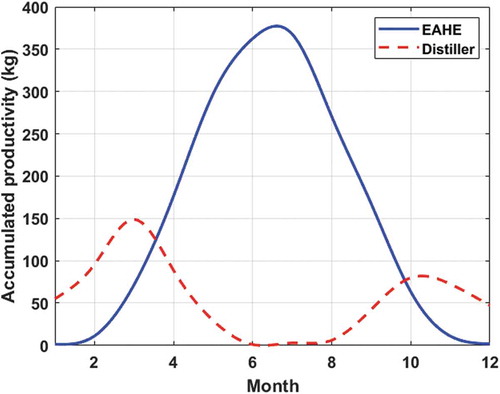
Furthermore, it is noted that the productivity of the solar still is higher in the cold and moderate weather due to the lower glass temperature in comparison with the dew point of the humid air, which enhances the condensation potential. The effect of the soil depth on the monthly accumulative productivity is shown in . After a certain depth, it looks no significant impact on productivity. The increase of the depth from 3 m to 5 m increases the average annual productivity by only 2.58%.
3.5 Soil temperature
shows the soil temperature as a function of time and depth (see Equationequation 41)(41)
(41) . The fluctuation of the soil temperature decreases and the profile tend to be more uniform as the soil depth increases furthermore, the maximum and minimum temperatures are shifted towards the right of the warmest and coldest months (July and January) due to the effect of the heat capacity of the soil.
3.6 Solar chimney
The updraught air velocity in the solar chimney for different values of the chimney height is explained in . The velocity trend is similar to that of the solar radiation incident on the collector also it’s seen an increase in the velocity with chimney height due to the rise in the updraught pressure with increasing the chimney height.
3.7 Comparison with the other work
and indicate a comparison of air temperature and humidity ratio in the EAHE between the present work and the work by Fuxin et al. (Citation2015). The inlet parameters (air velocity, soil temperature, and pipe diameter are 1.5 m/s, 12 °C, and 0.5 m, respectively,). The average percentage differences for air temperature and humidity ratio between the two works are 3.98%, and 11.0%, respectively.
Figure 15. Comparison of the present work and that of Fuxin et al. (Citation2015), (RHinlet = 60%)
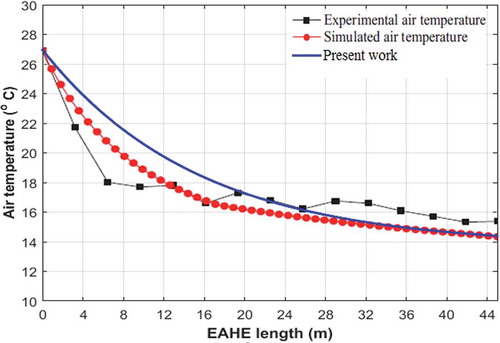
Figure 16. Comparison of the present work and that of Fuxin et al. (Citation2015), (RHinlet = 90%)
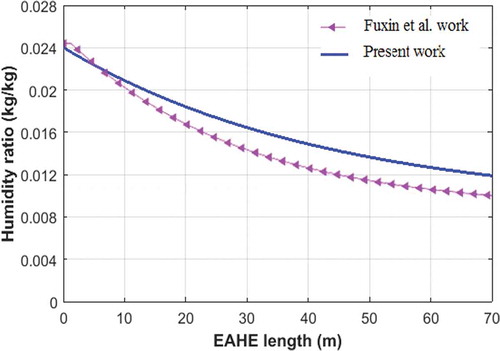
4. System efficiency and cost estimation
Hourly efficiency of the system is the ratio of latent heat released due to condensation of water vapour from the moist air in the solar still and EAHE to the solar radiation incident on the solar still. Mathematically it’s given by (Rabhi et al. Citation2017):
The hourly efficiency of the system shown in was carried out for July and compared with the work by Okati, Farsad, and Behzadmehr (Citation2018). The efficiency increasing from 0.226 at 6:00 to reach 0.46 at 18:26 before sharp increases to 0.87 just after 20:00. The sharp increase of efficiency is due to the fast-falling of the solar radiation while evaporation and condensation continue due to the thermal inertia of the water in the solar still basin. The difference between the two works is due to the different weather conditions and the soil temperatures. In the present work, the soil temperature is 27.32 °C while it was 17 °C for Okati work.
Figure17. Efficiency of the present work and that of Okati et al. (Citation2018)
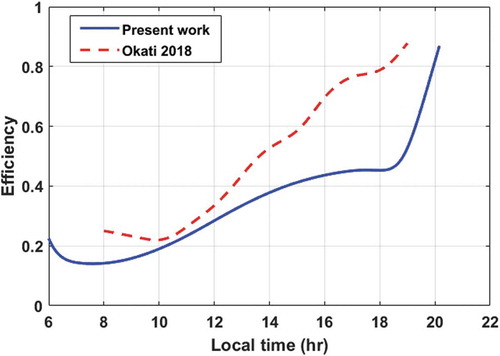
An economic evaluation was done by using Kabeel, Omara, and Essa (Citation2014) method. The costs of the items used in the system are listed in . The total fixed cost of the system is estimated to be F = 4840 USD. Assuming that V = 0.3 × F represents variable annual costs and C the total variable and constant costs i.e. C = F + V, if the average life of the equipment used is taken as 10 years, then the total cost is C = 4840 + 0.3 × 10 × 4840 = 19,360 USD. The total daily freshwater yield for the solar still and the EAHE is 207.44 kg. The annual average percentage of sunny days in Basra city through four years 2016–2019 is 90.8%, and therefore the total amount of freshwater produced in the 10 years is:
Table 3. Estimation of the system cost
Amount of fresh water production = 207.44 × 10 × 365 × 0.908 = 687,497.65 kg
Cost of fresh water production (kg) = 19,360/687,497.65 = 0.0282 $
5. Conclusions
A theoretical model of humidification-dehumidification processes in a combination of a solar still and an earth-air heat exchanger with natural air circulation by using a solar chimney is presented. Humidification-dehumidification processes in a transient mode in the whole system are formulated and numerically simulated. It was found that the use of an earth-air heat exchanger is notable for freshwater production from a humidified air and the coupling of a solar still with an earth-air heat exchanger is reliable for continuous freshwater production throughout the year. The maximum productivity of the EAHE occurred within the warm weather, while the solar still has maximum productivity in the cold weather.
The average daily freshwater produced by the entire system throughout the year was 207.44 kg (151.64 kg for the earth-air heat exchanger and 55.8 kg for the solar still). The largest amount of fresh water produced by the entire system (EAHE and solar still) was obtained during the hottest months (June and July) while the minimum productivity was obtained within the coldest months (December and January). The annual productivity of the EAHE was found to be about three times that of the solar still and the condensation rate is greatly dependent on the solar radiation intensity. The humidification and dehumidification processes in the system strongly depend on the solar radiation intensity also the natural air circulation in the system is significantly affected by the solar irradiance as well as the chimney height. No significant effect was found for the soil depth on EAHE productivity after 5 m depth where the soil temperature is reached a uniform value of 27 °C. The average thermal efficiency of the system for the daytime (6:00 to 19:00) was 33.07%.
Nomenclature
A area (m2)
Aco collector area (m2)
Ap surface area of pipe (m2)
As annual surface temperature
amplitude (°C)
Ach chimney cross-section area (m2)
Cd discharge coefficient (-)
Cpf specific heat of air (J/kg°C)
Cw specific heat of water (J/kg°C)
Dab Binary diffusion coefficient (m2 /s)
Dp EAHE pipes diameter (m)
g gravity acceleration (m/s2)
Hch chimney height (m)
ha heat transfer coefficient between
glass and surrounding (W/m 2 °C)
hw heat transfer coefficient between
water and air (W/m 2 °C)
hf heat transfer coefficient between
air and glass (W/m 2 °C)
hm convective mass transfer coefficient (m/s)
hfg latent heat of evaporation (J/kg)
hg enthalpy of saturated vapour (J/kg)
hv enthalpy of vapour (J/kg)
I total solar radiation (W/m 2)
j day of year counted from January 1st
L latitude angle (degree)
air mass flow rate (kg/s)
solar still condensation rate (kg/s)
evaporation rate (kg/s)
EAHE condensation rate (kg/s)
P atmospheric pressure (N/m2)
saturated pressure at the glass
temperature (N/m2)
saturated pressure at the air
temperature (N/m2)
saturated pressure at the water
temperature (N/m2)
convection heat transfer between
air and glass (W)
convection heat transfer between
water and air (W)
evaporative heat transfer between water
and air (W)
condensation heat transfer between air
and glass (W)
convection heat transfer between air
and glass (W)
air and EAHE pipe wall (W)
condensation heat transfer between
air and EAHE pipe wall (W)
S day length (m)
Sc Schmidt number
Sh Sherwood number
Ta,max monthly maximum ambient
temperature (°C)
Ta,min monthly minimum ambient
temperature (°C)
Ta ambient temperature (°C)
Tdp dew point temperature (°C)
Tf airstream temperature (°C)
average air temperature (°C)
Tg glass temperature (°C)
Tm average annual soil temperature (°C)
Tw water temperature (°C)
t time (s)
Tp EAHE pipe wall temperature (°C)
Tco air temperature in the collector
Ts soil temperature (°C)
to time of minimum surface temperature
from the start of the year, (hr)
Ua wind velocity (m/s)
Uf airstream velocity (m/s)
w humidity ratio (kg of vapour/kg of dry air)
average humidity ratio of air
(kg of vapour/kg of dry air)
wp humidity ratio in EAHE (kg of vapour/kg
of dry air)
x solar still horizontal coordinate (m)
y soil depth (m)
z EAHE horizontal coordinate (m)
Greek letters
glass absorptivity (-)
water absorptivity (-)
soil diffusivity (m2 /s)
altitude angle (degree)
relative humidity (-)
δ declination angle (degree)
ℓ latitude angle (degree)
λ hour angle (degree)
glass transmissivity (-)
Subscript
f air inside the solar still
g glass
i inlet
o outlet
s saturation
w water
Disclosure Statement
No conflict of interest was reported by the author(s).
Additional information
Notes on contributors
Salman H. Hammadi
Dr. Salman H. Hammadi, Professor in mechanical engineering, Basrah University, college of mechanical engineering, Basra, Iraq. Interested field: Renewable energy, Solar desalination, and air conditioning.
References
- Abdullah, A. S., M. M. Younes, Z. M. Omara, and F. A. Essa. 2020. “New Design of Trays Solar Still with Enhanced Evaporation Methods –comprehensive Study.” Solar Energy 203: 164–174. doi:https://doi.org/10.1016/j.solener.2020.04.039.
- Al-Ajmi, F., D. L. Loveday, and V. I. Hanby. 2006. “The Cooling Potential of Earth–air Heat Exchangers for Domestic Buildings in a Desert Climate.” Building and Environment 41 (3): 235–244. doi:https://doi.org/10.1016/j.buildenv.2005.01.027.
- Al-Enezi, F. Q., J. K. Sykulski, and A. A. Nabil. 2011. “Visibility and Potential of Solar Energy on Horizontal Surface at Kuwait Area.” Energy Procedia 12: 862–872. doi:https://doi.org/10.1016/j.egypro.2011.10.114.
- Ali, H. M. 1991. “Experimental Study on the Air Motion Effect inside the Solar Still on Still Performance.” Energy Convers Mgmt 32 (1): 67–70. doi:https://doi.org/10.1016/0196-8904(91)90144-8.
- Ali, H. M. 1993. “Effect of Forced Convection inside the Solar Still on Heat and Mass Transfer Coefficients.” Energy Convers. Mgmt 34 (1): 73–79. doi:https://doi.org/10.1016/0196-8904(93)90009-Y.
- Ali, I. S., A. E. Kabeel, M. M. K. Dawood, A. M. Elharidi, A. B. Elsalam, K. Ramzy, and A. Mehanna. 2020. “Enhancement of the Productivity for Single Solar Still with Ultrasonic Humidifier Combined with Evacuated Solar Collector: An Experimental Study.” Energy Conversion and Management 208: 112592. doi:https://doi.org/10.1016/j.enconman.2020.112592.
- Amer, E. H., H. Kotb, G. H. Mostafa, and A. R. El-Ghalban. 2009. “Theoretical and Experimental Investigation of Humidification–dehumidification Desalination Unit.” Desalination 249 (3): 949–959. doi:https://doi.org/10.1016/j.desal.2009.06.063.
- Ayman, R. A., and H. Hassan. 2020. “Enhancement of Hybrid Solar Desalination System Composed of Solar Panel and Solar Still by Using Porous Material and Saline Water Preheating.” Solar Energy 204: 382–394. doi:https://doi.org/10.1016/j.solener.2020.04.058.
- Bassiouny, R., and N. S. A. Koura. 2008. “An Analytical and Numerical Study of Solar Chimney Use for Room Natural Ventilation.” Energy and Buildings 40 (5): 865–873. doi:https://doi.org/10.1016/j.enbuild.2007.06.005.
- Besharat, F., A. A. Dehghan, and A. R. Faghih. 2013. “Empirical Models for Estimating Global Solar Radiation: A Review and Case Study.” Renew. Sustain. Energy Rev 21: 798–821. doi:https://doi.org/10.1016/j.rser.2012.12.043.
- Bhargva, M., and A. Yadav. 2020. “Experimental Comparative Study on a Solar Still Combined with Evacuated Tubes and a Heat Exchanger at Different Water Depths.” International Journal of Sustainable Engineering 13 (3): 218–229. doi:https://doi.org/10.1080/19397038.2019.1653396.
- Cengel, Y. A., and M. A. Boles. 2001. Thermodynamics: An Engineering Approach. 3rd Edition Mcgraw-Hill.
- Çengel, Y. A., and A. J. Ghajar. 2015. Heat and Mass Transfer Fundamentals and Applications. fifth edition ed. 2 Penn Plaza, New York, NY 10121: McGraw-Hill Education.
- Chaabene, M., and M. Annabi. 1997. “A Dynamic Model for Predicting Solar Plant Performance and Optimum Control.” Energy 22 (6): 567–578. doi:https://doi.org/10.1016/S0360-5442(96)00141-7.
- De Paepe, M., and A. Janssens. 2003. “Thermo-hydraulic Design of Earth-air Heat Exchanger.” Energy and Building 35 (4): 389–397. doi:https://doi.org/10.1016/S0378-7788(02)00113-5.
- El Mghouchi, Y., A. El Bouardi, Z. Choulli, and T. Ajzoul. 2016. “Models for Obtaining the Daily Direct, Diffuse and Global Solar Radiations.” Renew. Sustain. Energy Rev 56: 87–99. doi:https://doi.org/10.1016/j.rser.2015.11.044.
- Elango, C., N. Gunasekaran, and K. Sampathkumar. 2015. “Thermal Models of Solar still—A Comprehensive Review.” Renewable and Sustainable Energy Reviews 47: 856–911. doi:https://doi.org/10.1016/j.rser.2015.03.054.
- Estrada, E., M. Labat, S. Lorente, and L. A. O. Rocha. 2018. “The Impact of Latent Heat Exchanges on the Design of Earth-Air Heat Exchangers.” Applied Thermal Engineering 129 (25): 306–317. doi:https://doi.org/10.1016/j.applthermaleng.2017.10.007.
- Fuxin, N., Y. Yu, D. Yu, and H. Li. 2015. “Heat and Mass Transfer Performance Analysis and Cooling Capacity Prediction of Earth to Air Heat Exchanger.” Applied Energy 137: 211–221. doi:https://doi.org/10.1016/j.apenergy.2014.10.008.
- Ghazy, A., and H. E. S. Fath. 2016. “Solar Desalination System of Combined Solar Still and Humidification–dehumidification Unit.” Heat Mass Transfer 52 (11): 2497–2506. doi:https://doi.org/10.1007/s00231-016-1761-1.
- Hamed, M. H., A. E. Kabeel, Z. M. Omara, and S. W. Sharshir. 2015. “Mathematical and Experimental Investigation of a Solar Humidification–dehumidification Desalination Unit.” Desalination 358: 9–17. doi:https://doi.org/10.1016/j.desal.2014.12.005.
- Hammadi, S. H. 2018. “Tempering of Water Storage Tank Temperature in Hot Climates Regions Using Earth Water Heat Exchanger.” Thermal Science and Engineering Progress 6: 157–163. doi:https://doi.org/10.1016/j.tsep.2018.03.009.
- Hassan, E. S. F., S. Elsherbiny, and A. Ghazy. 2004. “A Naturally Circulated Humidifying/dehumidifying Solar Still with A Built-in Passive Condenser.” Desalination 169 (2): 129–149. doi:https://doi.org/10.1016/S0011-9164(04)00521-1.
- Incropera, F. P. 2006. Fundamentals of Heat and Mass Transfer. 6th edition. Wiley, New York.
- Jianliu, X., and L. Weihua. 2013. “Study on Solar Chimney Used for Room Natural Ventilation in Nanjing.” Energy and Buildings 66: 467–469. doi:https://doi.org/10.1016/j.enbuild.2013.07.036.
- Kabeel, A. E., Z. M. Omara, and F. A. Essa. 2014. “Improving the Performance of Solar Still by Using Nanofluids and Providing Vacuum.” Energy Conversion and Management 86: 268–274. doi:https://doi.org/10.1016/j.enconman.2014.05.050.
- Keshtkar, M., M. Eslami, and K. Jafarpur. 1993. “Effect of Design Parameters on Performance of Passive Basin Solar Stills considering Instantaneous Ambient Conditions: A Transient CFD Modeling.” Solar Energy 201: 884–907. doi:https://doi.org/10.1016/j.solener.2020.03.068.
- Lawrence, M. G. 2005. “The Relationship between Relative Humidity and the Dew Point Temperature in Moist Air: A Simple Conversion and Applications.” Bulletin of the American Meteorological Society 86 (2): 225–233. doi:https://doi.org/10.1175/BAMS-86-2-225.
- Lindblom, J., and B. Nordell. 2006. “Water Production by Underground Condensation of Humid Air.” Desalination 189 (1–3): 248–260. doi:https://doi.org/10.1016/j.desal.2005.08.002.
- Lindblom, J., and B. Nordell. 2007. “Underground Condensation of Humid Air for Drinking Water Production and Subsurface Irrigation.” Desalination 203 (1–3): 417–434. doi:https://doi.org/10.1016/j.desal.2006.02.025.
- Mawire, A., and M. McPherson. 2008. “Experimental Characterization of a Thermal Energy Storage System Using Temperature and Power Controlled Charging.” Renewable Energy 33 (4): 682–693. doi:https://doi.org/10.1016/j.renene.2007.04.021.
- Mohamed, A. S. A., A. G. Shahdy, and M. S. Ahmed. 2021. “Investigation on Solar Humidification Dehumidification Water Desalination System Using a Closed-air Cycle.” Applied Thermal Engineering 188: 116621. doi:https://doi.org/10.1016/j.applthermaleng.2021.116621.
- Molineaux, B., B. Lachal, and O. Guisan. 1994. “Thermal Analysis of Five Outdoor Pools Heated by Unglazed Solar Collectors.” Solar Energy 53 (1): 21–26. doi:https://doi.org/10.1016/S0038-092X(94)90599-1.
- Okati, V., A. Behzadmehr, and S. Farsad. 2016. “Analysis of a Solar Desalinator (Humidification–dehumidification Cycle) Including a Compound System Consisting of a Solar Humidifier and Subsurface Condenser Using DoE.” Desalination 397: 9–21. doi:https://doi.org/10.1016/j.desal.2016.06.010.
- Okati, V., S. Farsad, and A. Behzadmehr. 2018. “Numerical Analysis of an Integrated Desalination Unit Using Humidification-dehumidification and Subsurface Condensation Processes.” Desalination 433: 172–185. doi:https://doi.org/10.1016/j.desal.2017.12.029.
- Ozgener, O., L. Ozgener, and J. W. Tester. 2013. “A Practical Approach to Predict Soil Temperature Variations for Geothermal (Ground) Heat Exchangers Applications.” International Journal of Heat and Mass Transfer 62: 473–480. doi:https://doi.org/10.1016/j.ijheatmasstransfer.2013.03.031.
- Rabhi, K., R. Nciri, F. Nasri, C. Ali, and H. B. Bacha. 2017. “Experimental Performance Analysis of a Modified Single-basin Single-slope Solar Still with Pin Fins Absorber and Condenser.” Desalination 416: 86–93. doi:https://doi.org/10.1016/j.desal.2017.04.023.
- Reicosky, D. C., L. J. Winkelman, J. M. Baker, and D. G. Baker. 1989. “Accuracy of Hourly Air Temperatures Calculated from Daily Minima and Maxima.” Agricultural and Forest Meteorology 46 (3): 193–209. doi:https://doi.org/10.1016/0168-1923(89)90064-6.
- Rogers, R. R., and M. K. Yau. 1989. A Short Course in Cloud Physics. Pergamon Press.
- Sartori, E. 1996. “Solar Still versus Solar Evaporator: A Comparative Study between Their Thermal Behaviors.” Solar Energy 56 (2): 199–206. doi:https://doi.org/10.1016/0038-092X(95)00094-8.
- Sartori, E. 2006. “Convection Coefficient Equations for Forced Airflow over Flat Surfaces.” Solar Energy 80 (9): 1063–1071. doi:https://doi.org/10.1016/j.solener.2005.11.001.
- Sharshir, S. W., G. Peng, N. Yang, M. A. Eltawil, M. K. Ahmed Ali, and A. E. Kabeel. 2016. “A Hybrid Desalination System Using Humidification-dehumidification and Solar Stills Integrated with Evacuated Solar Water Heater.” Energy Conversion and Management 124: 287–296. doi:https://doi.org/10.1016/j.enconman.2016.07.028.
- Sivaram, P. M., S. Dinesh Kumar, M. Premalatha, T. Sivasankar, and A. Arunagiri. 2021. “Experimental and Numerical Study of Stepped Solar Still Integrated with a Passive External Condenser and Its Application.” Environment, Development and Sustainability 23 (2): 2143–2171. doi:https://doi.org/10.1007/s10668-020-00667-4.
- Zanganeh, P., A. S. Goharrizi, S. Ayatollahi, M. Feilizadeh, and H. Dashti. 2020. “Efficiency Improvement of Solar Stills through Wettability Alteration of the Condensation Surface: An Experimental Study.” Applied Energy 268: 114923. doi:https://doi.org/10.1016/j.apenergy.2020.114923.

